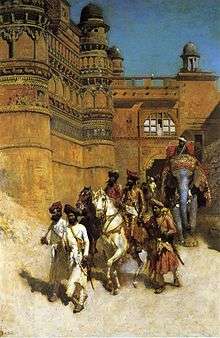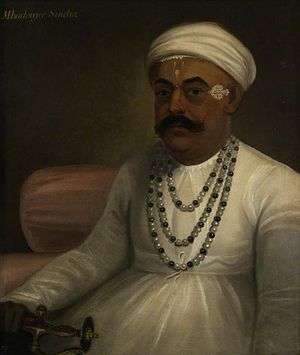Scindia
Scindia dynasty (anglicized from Shinde and also spelled popularly as Shinde in Maharashtra), is a Hindu Maratha dynasty that ruled the erstwhile State of Gwalior. The Gwalior state was a part of the Maratha Confederacy in the 18th and 19th centuries, and a princely state of the colonial British government during the 19th and the 20th centuries. After India's independence in 1947, several members of the Sindhia family went on to join Indian politics.
Foundation
The Scindia dynasty was founded by Ranoji Shinde, who was a Maratha sardar of Peshwa Bajirao and from a younger branch of Shinde Patils from Kanherkhed.[1] Prior to this they served as shiledars (cavalrymen) under the Bahmani Sultanate and played an important role in the state of affairs.[2]
Origin and history

Lineage
According to records of British period there are several anecdotes about origin of Scindhias ,specially Sir John Malcolm's record illustrates that:
Scindhia hailed from cultivator caste Kunbi like Holkars who were of Dhangar origin.In ritual status they were regarded as Maratha.The founder of Scindhia dynasty ""Ranoji"" was in service of Peshwa Bajirao. One day Bajirao came out of his camp and Showed his servant(Ranoji) sleeping with his sleepers.He was so impressed with faithfulness of his servant that he promoted him to his bodyguard .[3] Stewart Gordon,also agrees to this origin theory of all Maratha sardars.[4]
Maratha Period
The Scindia dynasty was founded by Ranoji Scindia, who was the son of Jankojirao Scindia, the Deshmukh of Kanherkhed, a village in Satara District, Maharashtra. Peshwa Baji Rao's career saw the strengthening of the Maratha Empire. Ranoji was in charge of the Maratha conquests in Malwa in 1726. Ranoji established his capital at Ujjain in 1731. His successors included Jayajirao, Jyotibarao, Dattajirao, Jankojirao, Mahadji Shinde and Daulatrao Scindia. The Scindhia state of Gwalior became a major regional power in the latter half of the 18th century and figured prominently in the three Anglo-Maratha Wars. They held sway over many of the Rajput states, and conquered north India.
British Rule: After the defeat of the allied Maratha states by the British in the Third Anglo-Maratha War of 1818, Daulatrao Shinde was forced to accept local autonomy as a princely state within British-occupied India and to give up Ajmer to the British. After the death of Daulatrao, Maharani Baiza Bai ruled the empire, saving it from the British power, till the adopted child Jankoji Rao took over the charge. Jankoji died in 1843, and his widow Tarabai Raje Scindia successfully maintained the position and adopted a child from close lineage named Jayajirao.
Independent India: The Scindia family ruled Gwalior until India's independence from the United Kingdom in 1947, when the Maharaja Jivajirao Scindia acceded to the Government of India. Gwalior was merged with a number of other princely states to become the new Indian state of Madhya Bharat. George Jivajirao served as the state's rajpramukh, or appointed governor, from 28 May 1948 to 31 October 1956, when Madhya Bharat was merged into Madhya Pradesh.
In 1962, Rajmata Vijayraje Scindia, the widow of Maharaja Jiwajirao, was elected to the Lok Sabha, beginning the family's career in electoral politics.[5] She was first a member of the Congress Party, and later became an influential member of the Bharatiya Janata Party. Her son Madhavrao Scindia was elected to the Lok Sabha in 1971 representing the Jansangh Party, he joined Congress in 1980 and served until his death in 2001. His son, Jyotiraditya Scindia, joined the Congress Party and was elected to the seat formerly held by his father in 2004. He later joined the Bharatiya Janata Party on 11 March 2020.
Vijayaraje's daughters have supported the Bharatiya Janata Party. Vasundhara Raje Scindia contested and won five parliamentary elections from Madhya Pradesh and Rajasthan. Under the Vajpayee government from 1998 onwards, Vasundhara was in charge of several different ministries. In 2003 she led the Bharatiya Janata Party to its largest majority in Rajasthan, and became the state's Chief Minister.[6] In 2013 again, she led Bharatiya Janata Party to a thumping win in the state of Rajasthan, winning over 160 out of the 200 seats in the assembly elections. Her other daughter, Yashodhara Raje Scindia, contested assembly elections from Shivpuri in Madhya Pradesh and won in 1998, 2003 and 2013 and also lok sabha 2004, 2009 from Gwalior. Upon the BJP's win in the state, she became the state's Minister for Tourism, Sports and Youth Affairs. Vasundhara's son Dushyant Singh entered the Lok Sabha in 2004 from Rajasthan.[7]
Titles
In the course of their military service, the Shinde were bestowed numerous titles by the British Empire, which grew more elaborate with the passage of time:
- 1745: Shrimant Sardar (name) Shinde Bahadur (Brave Chief of the Shinde)
- 1745–1787: Meherban Shrimant Sardar (name) Shinde Bahadur (High and Brave Chief of the Shinde)
- 1787–1790: His Highness Maharajadhiraja Maharaja Sahib Subadar Shrimant (name) Shinde Bahadur Maharaja Shinde of Gwalior (His Highness the Great King over Kings, High and Brave Lord of the Shinde, Shinde King of Gwalior)
- 1790–1794: His Highness Ali Jah, Umdat ul-Umara, Farzand-i-Arjumand, Maharajadhiraja Maharaja Sahib Subadar Shrimant (name) Shinde Bahadur, Shrinath, Mansur-i-Zaman, Naib ul-Istiqlal-i-Maharajadhiraj Sawai Madhav Rao Narayan, Maharaja Shinde of Gwalior (His Highness the Exalted Dignity, Pillar of the Nobility, Worthy Son, Great King over Kings and Lord Chieftain of the Brave Shinde, Lord of Fortune, Victorious of the Age, Permanent Deputy of the Peshwa, Shinde King of Gwalior)
- 1794–1827: His Highness Ali Jah, Naib Vakil-i-Mutlaq, Amir ul-Umara, Mukhtar ul-Mulk, Maharajadhiraja Maharaja Shrimant (name) Shinde Bahadur, Maharaja Shinde of Gwalior (His Highness the Exalted Dignity, Deputy Agent, Amir of Amirs, Agent of the Kingdom, Great King over Kings of the Brave Shinde, Shinde King of Gwalior)
- 1827–1845: His Highness Ali Jah, Umdat ul-Umara, Hisam us-Sultanat, Mukhtar ul-Mulk, Maharajadhiraja Maharaja Shrimant (name) Shinde Bahadur, Shrinath, Mansur-i-Zaman, Maharaja Shinde of Gwalior (His Highness the Exalted Dignity, Pillar of the Nobility, Sword of the Kingdom, Agent of the Kingdom, Great King over Kings of the Brave Shinde, Lord of Fortune, Victorious of the Age, Shinde King of Gwalior)
- 1845–1861: His Highness Ali Jah, Umdat ul-Umara, Hisam us-Sultanat, Mukhtar ul-Mulk, Azim ul-Iqtidar, Rafi-us-Shan, Wala Shikoh, Muhtasham-i-Dauran, Maharajadhiraja Maharaja Shrimant (name) Shinde Bahadur, Shrinath, Mansur-i-Zaman (His Highness the Exalted Dignity, Pillar of the Nobility, Sword of the Kingdom, Agent of the Kingdom, Chief of the Highest Authority, High in Prestige, Exalted in Dignity, Great Prince over Princes of the Brave Shinde, Lord of Fortune, Victorious of the Age)
- 1861–1901: His Highness Ali Jah, Umdat ul-Umara, Hisam us-Sultanat, Mukhtar ul-Mulk, Azim ul-Iqtidar, Rafi-us-Shan, Wala Shikoh, Muhtasham-i-Dauran, Maharajadhiraja Maharaja Shrimant (name) Shinde Bahadur, Shrinath, Mansur-i-Zaman, Fidvi-i-Hazrat-i-Malika-i-Mua'zzama-i-Rafi-ud-Darja-i-Inglistan (His Highness the Exalted Dignity, Pillar of the Nobility, Sword of the Kingdom, Agent of the Kingdom, Chief of the Highest Authority, High in Prestige, Exalted in Dignity, Great Prince over Princes of the Brave Shinde, Lord of Fortune, Victorious of the Age, Vassal of Her Majesty the Honoured and Exalted Queen of England)
- 1901–1952: His Highness Ali Jah, Umdat ul-Umara, Hisam us-Sultanat, Mukhtar ul-Mulk, Azim ul-Iqtidar, Rafi-us-Shan, Wala Shikoh, Muhtasham-i-Dauran, Maharajadhiraja Maharaja Shrimant (name) Shinde Bahadur, Shrinath, Mansur-i-Zaman, Fidvi-i-Hazrat-i-Malik-i-Mua'zzam-i-Rafi-ud-Darjat-i-Inglistan (His Highness the Exalted Dignity, Pillar of the Nobility, Sword of the Kingdom, Agent of the Kingdom, Chief of the Highest Authority, High in Prestige, Exalted in Dignity, Great Prince over Princes of the Brave Shinde, Lord of Fortune, Victorious of the Age, Vassal of His Majesty the Honoured and Exalted King of England)
- 1952–1969: His Highness Ali Jah, Umdat ul-Umara, Hisam us-Sultanat, Mukhtar ul-Mulk, Azim ul-Iqtidar, Rafi-us-Shan, Wala Shikoh, Muhtasham-i-Dauran, Maharajadhiraja Maharaja Shrimant (name) Shinde Bahadur, Shrinath, Mansur-i-Zaman, Fidvi-i-Hazrat-i-Malika-i-Mua'zzama-i-Rafi-ud-Darja-i-Inglistan (His Highness the Exalted Dignity, Pillar of the Nobility, Sword of the Kingdom, Agent of the Kingdom, Chief of the Highest Authority, High in Prestige, Exalted in Dignity, Great Prince over Princes of the Brave Shinde, Lord of Fortune, Victorious of the Age, Vassal of Her Majesty the Honoured and Exalted Queen of England)
Shinde Maharajas of Ujjain and Gwalior

- Ranoji Rao Shinde (1731 – 19 July 1745). Died 19 July 1745.
- Jayappa Rao Shinde (1745 – 25 July 1755). Born c. 1720, died 25 July 1755.
- Jankoji Rao Scindia I (25 July 1755 – 15 January 1761). Born in 1745. died 15 January 1761.
- Dattaji Rao Scindia (Regent 1755 – 10 January 1760). Died 10 January 1760.
- Vacant 15 January 1761 – 25 November 1763
- Kadarji Rao Scindia (25 November 1763 – 10 July 1764) Died ?.
- Manaji Rao Scindia (10 July 1764 – 18 January 1768) Died ?.
- Mahadaji Scindia (18 January 1768 – 12 February 1794). Born 3 December 1730, died 12 February 1794.
- Daulat Rao Shinde (12 February 1794 – 21 March 1827). Born 1779, died 21 March 1827.
- Jankoji Rao Scindia II (18 June 1827 – 7 February 1843). Born 1805, died 7 February 1843.
- Jayaji Rao Scindia (7 February 1843 – 20 June 1886). Born 19 January 1835, died 20 June 1886.
- Madho Rao Scindia (20 June 1886 – 5 June 1925). Born 20 October 1876, died 5 June 1925.
- Jivajirao Scindia (Maharaja 5 June 1925 – 15 August 1947, Rajpramukh 28 May 1948 – 31 October 1956. Last Maharaja, later Rajpramukh) Born 26 June 1916, died 16 July 1961.
- Madhavrao Scindia (1961-1971) The Last Maharaja, before the abolishment of monarchy in 1971.
- Jyotiraditya Scindia
- Mahanaaryaman Jyotiraditya Scindia (b.1995) (next in line)
References
- Burway M.W, Life of Ranoji Rao Sindhia Founder of the Gwalior State, Pg.2
- Richard M. Eaton (19 December 2005). A social history of the Deccan, 1300-1761: eight Indian lives. Cambridge University Press. pp. 188–. ISBN 978-0-521-25484-7. Retrieved 16 July 2011.
- Ramusack, Barbara N. (2004). The Indian Princes and their States. The New Cambridge History of India. Cambridge University Press. p. 35&36. ISBN 9781139449083.
- Stewart Gordon (16 September 1993). The Marathas 1600-1818. Cambridge University Press. pp. 15–. ISBN 978-0-521-26883-7.
Looking backward from ample material on the eighteenth and nineteenth centuries, we know that Maratha as a category of caste represents the amalgamation of families from several castes - Kunbi, Lohar, Sutar, Bhandari, Thakar, and even Dhangars (shepherds) – which existed in the seventeenth century and, indeed, exist as castes in Maharashtra today. What differentiated, for example, "Maratha" from "Kunbi"? It was precisely the martial tradition, of which they were proud, and the rights (watans and inams) they gained from military service. It was these rights which differentiated them from the ordinary cultivator, ironworkers and tailors, especially at the local level
- "Archived copy". Archived from the original on 11 February 2007. Retrieved 4 December 2006.CS1 maint: archived copy as title (link)
- Life and Career - Vasundhara Raje
- "Dushyant Singh wins". NDTV.
- N. G. Rathod (1994). The Great Maratha Mahadaji Scindia. Sarup & Sons. p. 8. ISBN 978-81-85431-52-9.
Further reading
- Yule, Sir Henry; Burnell, Arthur Coke (1903), William Crooke (ed.), Hobson-Jobson: a Glossary of Colloquial Anglo-Indian Words and Phrases, and of Kindred Terms, Etymological, Historical, Geographical and Discursive, London: J. Murray, OCLC 4718658CS1 maint: ref=harv (link)
- Hope, John (1863). The House of Scindea — A Sketch by John Hope. Longman, Green, Longman, Roberts & Green, London.
- Neelesh Ishwarchandra Karkare (2017). Tawaareekh-E-ShindeShahi. ISBN 978-93-5267-241-7.
External links
![]()